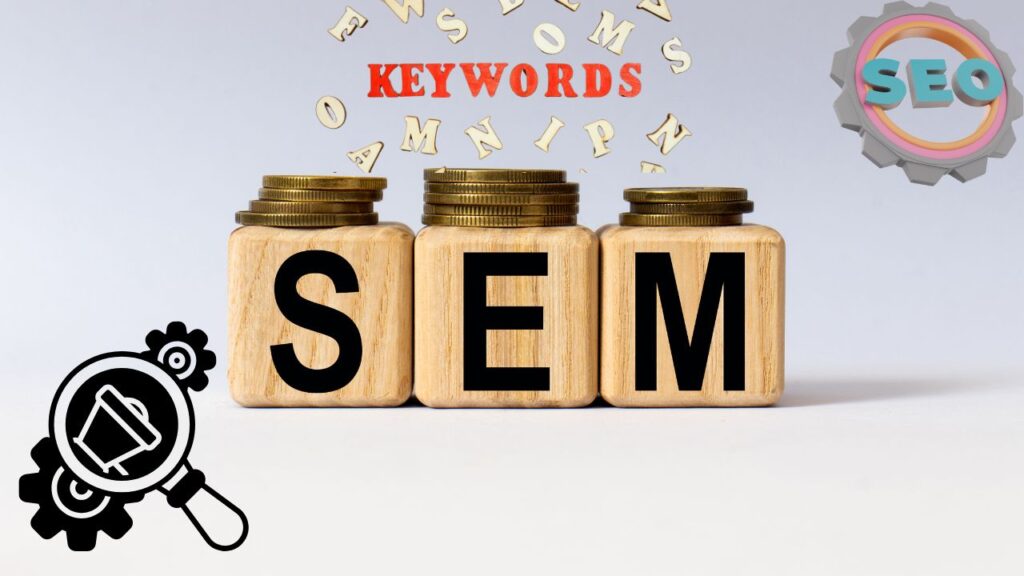Understanding SEM: What is SEM in Simple Words
When you hear the term SEM, you might wonder what it really means. SEM stands for Search Engine Marketing. In simple words, it is a way to promote websites through paid advertisements on search engines. These ads appear on search engine results pages (SERPs) when users search for certain keywords. Let’s break this down and understand how SEM works, why it’s important, and how it can benefit your business.
At its core, SEM is all about visibility. When you search for something on Google, you often notice sponsored links at the top or bottom of the page. These links are there because someone paid to have their site displayed there when you searched for related keywords. This is the essence of SEM: it’s about buying visits to your site instead of earning those visits organically through SEO (Search Engine Optimization).

Now, let’s explore the components of SEM in a clearer way:
- Keyword Research: This is the starting point for any SEM campaign. You need to identify the words and phrases your potential customers are searching for. Tools like Google Keyword Planner can help you find the best keywords to target.
- Ad Creation: Once you have your keywords, you’ll create ads. These ads should be catchy and relevant to what you’re selling. Think about what will grab the attention of someone browsing search results.
- Bidding: In SEM, you usually engage in a bidding process for your selected keywords. You maintain control over how much you are willing to pay each time someone clicks on your ad (this is known as Cost Per Click or CPC).
- Landing Page: When someone clicks your ad, they should be directed to a landing page that continues the message of your ad. This page must provide value to the visitor, leading them to take the desired action, whether it’s making a purchase, signing up, or downloading a resource.
- Analytics: You need to track how well your SEM efforts are performing. This includes monitoring click-through rates, conversion rates, and ROI (Return on Investment). Google Ads provides valuable insights for measuring success.
So, why should you consider using SEM for your business? Here are some compelling reasons:
- Immediate Results: Unlike SEO, which can take time to build up, SEM can provide quick results. As soon as your ads are live, you can start getting traffic.
- Targeted Audience: With SEM, you can target specific demographics and interests, ensuring that your ads are seen by people most likely to convert.
- Budget Control: You have full control over your spending. You can set daily budgets, choose how much you’re willing to pay per click, and pause campaigns whenever you want.
- Enhanced Visibility: By appearing at the top of search results, you increase your visibility, bringing more potential customers to your site.
Here is a simple comparison between SEM and SEO:
| Feature | SEM | SEO |
|---|---|---|
| Cost | Paid (CPC model) | Organic (free, but time-consuming) |
| Speed | Fast results | Slow results |
| Visibility | Immediate visibility | Gradual visibility |
| Ongoing Maintenance | Requires regular budget | Requires ongoing content updates |
To summarize, understanding SEM is essential if you’re looking to drive traffic and sales through online marketing. By leveraging paid search ads, you can reach out to potential customers in real-time based on their search queries. Whether you’re a small business or a large corporation, incorporating SEM into your marketing strategy can lead to increased visibility and growth.
What is SEM in Simple Words Ultimately, SEM is all about making connections. When you provide the right information and promote it effectively to the right audience, you stand to gain significant benefits. So, if you want to make an impact online, consider diving into the world of Search Engine Marketing.
The Difference Between SEM and SEO
What is SEM in Simple Words ? If you have ever heard about digital marketing, you might have come across two terms: SEM and SEO. While both focus on increasing visibility online, they work in different ways. Understanding these differences can help you select the right strategy for your needs.
SEM, or Search Engine Marketing, involves promoting a website through paid advertisements, while SEO, or Search Engine Optimization, is the process of optimizing a website to improve its organic ranking in search engine results.
Key Differences Between SEM and SEO
Let’s break down the main differences between SEM and SEO in clear terms. Here are several key aspects to consider:
- Cost: SEM requires you to spend money on ads, while SEO is largely about optimizing content without immediate costs. However, SEO often involves costs related to content creation and tools.
- Speed: SEM can bring immediate traffic to your site as ads appear as soon as you launch your campaign. On the other hand, SEO can take time to build; it might take weeks or months to see significant results.
- Longevity: Traffic generated through SEM stops as soon as your budget runs out. Conversely, well-optimized SEO content can continue to attract visitors for a long time, even without ongoing spending.
- Targeting: SEM allows for precise targeting based on keywords, demographics, and behaviors, giving advertisers control over their audience reach. SEO targets users based on the relevance of content and keywords used.
How SEM Works
SEM uses paid advertising to enhance visibility. Here’s how it typically functions:
- Keyword Research: Just like in SEO, the first step in SEM is identifying the right keywords that your potential customers are searching for.
- Ad Creation: Next, you create ads that will appear in search results. These ads can include text, images, or even video content.
- Bidding: You typically bid on keywords, determining how much you are willing to pay for each click on your ad.
- Analytics: you monitor the performance of your campaigns through analytics tools to see which ads work best.
How SEO Works
SEO involves optimizing your website and content for search engines. Here’s a simple breakdown of its components:
- On-Page SEO: This focuses on optimizing individual pages. Important elements include keyword usage, meta descriptions, headers, and internal linking.
- Off-Page SEO: This involves activities that take place outside your website, like link-building or social media engagement to boost overall credibility.
- Technical SEO: This refers to optimizing a website’s technical aspects, like site speed, mobile-friendliness, and structured data, ensuring search engines can easily crawl and index your site.
When to Use Each Strategy
This is a common question among marketers. Here are some scenarios to consider:
| Situation | Recommended Strategy |
|---|---|
| You need quick visibility. | SEM |
| You have a limited budget. | SEO |
| Your business has a long sales cycle. | SEO |
| You want immediate results | SEM |
In practice, many businesses find success using a combination of both SEM and SEO. This hybrid approach can leverage the immediate benefits of SEM while building long-term traffic through SEO efforts.
In the evolving landscape of digital marketing, understanding the differences between SEM and SEO can empower you to make informed decisions. By thoughtfully integrating both strategies, you can enhance your online presence and reach your target audience more effectively.
Key Components of an Effective SEM Strategy
What is SEM in Simple Words ?When you think about promoting your business online, a solid SEM strategy is essential. SEM, or Search Engine Marketing, encompasses various techniques aimed at increasing a website’s visibility in search engines through paid advertising. Implementing an effective SEM strategy can lead to higher traffic, better conversion rates, and improved brand awareness. Here are the key components that make up an effective SEM approach.
Keyword Research
One of the first steps in creating a successful SEM campaign is comprehensive keyword research. This involves identifying the terms your target audience uses when searching for products or services like yours. Focus on:
- Long-Tail Keywords: These are more specific phrases that usually have lower competition and can help in attracting more qualified visitors.
- Search Intent: Understand whether users are looking for information, making a purchase, or comparing products. This helps in tailoring the ads accordingly.
- Competitor Analysis: Investigate what keywords your competitors are targeting to identify gaps in your strategy.
Ad Creation
Your ads are often the first touchpoint for potential customers. Therefore, crafting compelling ad copy is crucial. A few tips include:
- Clear Messaging: Make sure your ad clearly explains what you offer and why users should click.
- Use of Keywords: Incorporate primary keywords in your ad copy to make it relevant to search queries.
- Call-to-Action (CTA): Encourage users to take a specific action, whether that’s visiting your website, signing up, or making a purchase.
Landing Pages
The landing page plays a vital role in converting clicks into sales or leads. Ensure your landing pages are optimized by considering the following:
- Relevancy: The content on your landing page should be directly related to the ad to provide a seamless experience.
- Mobile Optimization: A significant amount of web traffic comes from mobile devices. Ensure your landing pages are responsive and user-friendly on all devices.
- Fast Load Times: A slow-loading page can lead to high bounce rates. Use tools to optimize page speed.
Bid Management
Proper bid management is essential for controlling how much you spend on PPC campaigns. Strategies may include:
- Manual Bidding: This gives you control over your bid amounts for each keyword.
- Automated Bidding: Many platforms offer options that adjust your bids automatically based on set goals.
- Budget Allocation: Allocate your budget strategically across different campaigns and keywords to maximize ROI.
Performance Tracking and Analytics
Analyzing the performance of your SEM campaigns helps you understand what works and what doesn’t. Key metrics to focus on include:
- Click-Through Rate (CTR): Indicates the percentage of people who clicked your ad after seeing it.
- Conversion Rate: Measures how many visitors take a desired action after clicking your ad.
- Cost Per Acquisition (CPA): Determines how much you spend on average to acquire a customer.
Continuous Optimization
The best SEM strategies are built for improvement. Regularly assess your campaigns and tweak your strategies based on data. Key areas for optimization include:
- A/B Testing: Test different ad copies, landing pages, and keyword variations to see what yields the best performance.
- Adjusting Budgets: Shift budgets to campaigns that perform better to maximize profit.
- Keyword Refinement: Regularly review your keyword list to add new relevant keywords and remove underperforming ones.
What is SEM in Simple Words ? By focusing on these critical components, you can create a robust SEM strategy that effectively drives traffic and conversions. Remember, a well-planned SEM campaign is not just about immediate results but also about building a sustainable online presence that grows over time.
How to Measure SEM Success
What is SEM in Simple Words ? Measuring the success of your Search Engine Marketing (SEM) efforts is essential for understanding how well your strategies are performing. By focusing on various metrics, you can gauge the effectiveness of your campaigns and make adjustments to improve your results. Here’s a detailed look at some key metrics and methods you can use to measure SEM success.

Understanding Key Metrics
When it comes to SEM, several critical metrics help you understand your performance:
- Clicks: The number of times users click on your ads is a foundational metric. Monitoring clicks helps you gauge interest in your ads.
- Impressions: This refers to how many times your ad is displayed to users. High impressions with low clicks may indicate issues with ad relevance.
- Click-Through Rate (CTR): This is calculated by dividing the number of clicks by the number of impressions. A higher CTR suggests your ads are appealing to your target audience.
- Cost Per Click (CPC): This metric shows you how much you pay for each click. It’s crucial for budget management.
- Conversion Rate: This indicates the percentage of visitors who complete the desired action, like making a purchase or signing up for a newsletter. It’s calculated by dividing the number of conversions by the total clicks.
- Return on Investment (ROI): Understanding your ROI helps you assess whether your SEM efforts are profitable. It’s calculated by subtracting the cost of the campaign from the revenue generated, then dividing by the cost of the campaign.
Using Google Analytics
Google Analytics is a powerful tool for measuring SEM success. You can set up goals to track the effectiveness of your ads. Here’s how to use it:
- Set Up Tracking: Implement Google Analytics tracking codes on your website to collect data.
- Create Goals: Define specific actions you want users to take on your site, like making a purchase or filling out a form.
- Analyze Traffic Sources: Check where your traffic is coming from to identify which SEM campaigns are driving performance.
- Monitor Behavior Flow: Observe how users navigate your site after clicking your ads. This helps in identifying areas for improvement.
Evaluating Ad Performance
Another crucial part of measuring SEM success is evaluating individual ad performance. Consider these strategies:
- A/B Testing: Run two variations of an ad to see which performs better. Change one element at a time, like the headline or the call to action.
- Quality Score: Google assigns a quality score to your ads based on relevance, expected CTR, and landing page experience. A higher score can lead to better ad placements and lower CPC.
- Ad Position: Monitor where your ads are showing on the results page. Top positions typically yield higher CTRs.
Assessing Landing Page Performance
Your landing page plays a critical role in converting clicks into actions. Here’s what to look out for:
- Loading Speed: Ensure your landing page loads quickly. A slow page can frustrate users and lead to high bounce rates.
- Relevance: Make sure the content of the landing page aligns with the ad. Misalignment can confuse users.
- User Experience: A clean, easy-to-navigate layout can significantly improve conversion rates.
Adjusting Your Strategy
Based on the metrics and evaluations, you should continuously adjust your SEM strategy. Here are some tips:
- Optimize Ad Spend: Shift your budget towards the ads that perform better based on your analysis.
- Refine Keywords: Analyze which keywords are driving the most conversions and adjust your strategy accordingly.
- Focus on High-Performing Campaigns: Expand successful campaigns while reevaluating or pausing those that underperform.
By measuring these aspects of your SEM campaigns, you take the guesswork out of your marketing efforts. This data-driven approach ensures you can enhance your strategies while maximizing ROI. Remember, the key to SEM success lies in continuous learning and adapting to your audience’s needs!
Common SEM Mistakes to Avoid
Search Engine Marketing (SEM) can be a powerful strategy for businesses looking to grow their online presence. However, there are several common mistakes that people often make when trying to implement SEM. Understanding these errors is crucial to improving your marketing efforts and getting the best results.
What is SEM in Simple Words ? One of the biggest mistakes is failing to define clear goals. Without specific objectives, it’s difficult to measure success or know what you’re aiming for. Make sure to set goals that are SMART: Specific, Measurable, Achievable, Relevant, and Time-bound. For instance, instead of stating, “I want more traffic,” say, “I want to increase my website traffic by 20% in the next three months.”
Another issue is neglecting keyword research. Choosing the wrong keywords can lead to wasted budget and time. Invest time into discovering what keywords your target audience is using. Use tools such as Google Keyword Planner or SEMrush to find high-volume, low-competition keywords that will effectively reach your audience. Remember to consider long-tail keywords, as they often convert better.
Many people also make the mistake of not optimizing their ad copy. Compelling ad copy is key to attracting clicks. Ensure your ads include a strong call-to-action, relevant keywords, and clear messaging that highlights the value of your product or service. A/B testing different versions of your ads can also help determine what resonates best with your audience.
| Common SEM Mistakes | Consequences | How to Fix |
|---|---|---|
| Setting vague goals | Difficult to measure success | Use SMART goals |
| Poor keyword research | Low visibility and clicks | Utilize keyword tools |
| Unoptimized ad copy | Low click-through rates | Test and refine ads |
| Ineffective landing pages | High bounce rates | Improve landing page content |
| Ignoring negative keywords | Unqualified traffic | Regularly update negative keyword list |
Landing pages play a significant role in SEM success. Sometimes, businesses drive traffic to a page that isn’t optimized for conversions. Ensure your landing pages are user-friendly, load quickly, and provide clear information. A well-structured landing page should have relevant content, an effective layout, and persuasive elements that guide visitors toward taking action.
What is SEM in Simple Words ? Another mistake people often overlook is not monitoring their campaigns. SEM is not a “set it and forget it” strategy. Regularly review your campaign performance metrics. Tools like Google Analytics provide valuable insights into what is working and what isn’t. Analyze metrics such as click-through rates (CTR), conversion rates, and return on ad spend (ROAS). This will allow you to adjust your strategies as needed to achieve optimal results.
It’s also essential to avoid ignoring your competitors. Keeping an eye on what your competitors are doing can provide valuable insights into industry trends and strategies that work. Tools like SpyFu or SEMrush can help you analyze competitors’ ads, keywords, and performance. Use this data to inform your tactics and differentiate your offerings.
The mistake of neglecting mobile optimization can lead to missed opportunities. As more people search on their mobile devices, having a mobile-friendly website is critical. Ensure your ads and landing pages are responsive and provide a seamless user experience on all devices. Test your website’s loading speed and make adjustments if necessary, as a slow-loading site can deter potential customers.
Another common oversight is underutilizing ad extensions. Google Ads offers various types of ad extensions that can enhance your visibility and the effectiveness of your ads. These extensions can provide additional information and encourage users to click. When utilized correctly, ad extensions can improve your ad’s performance without additional costs.

Many marketers underestimate the importance of a well-planned budget. Setting an unrealistic budget or failing to allocate funds wisely can lead to campaigns that don’t deliver desired results. Plan your budget according to industry benchmarks and historical data from your previous campaigns. Make adjustments as needed to ensure your bids align with your goals.
Avoiding these common SEM mistakes can greatly increase your chances of running successful campaigns. By focusing on clear goals, effective keyword research, optimized ad copy, and continuous monitoring, you can drive better results and maximize your marketing investments.
Key Takeaway:
Key Takeaway: Mastering SEM for Online Success
In today’s digital landscape, understanding Search Engine Marketing (SEM) is essential for businesses seeking to increase their online visibility and drive traffic. At its core, SEM is a paid marketing strategy that helps you reach potential customers through paid advertisements on search engines like Google. Unlike Search Engine Optimization (SEO), which focuses on organic rankings, SEM provides a more immediate approach by targeting specific keywords through paid ads. This means you can secure a prominent spot in search results quickly—ideal for businesses that need to attract customers fast.
What is SEM in Simple Words ? An effective SEM strategy encompasses several key components. First, keyword research is fundamental as it helps you identify the phrases your target audience is searching for. Next, crafting compelling ad copy is vital to engage users, encouraging them to click through to your website. Furthermore, managing your budget and bids is crucial to ensure a good return on investment (ROI).
Measuring SEM success involves tracking various metrics, such as click-through rates (CTR), conversion rates, and overall return on ad spend (ROAS). These metrics offer insights into how well your campaigns are performing and where adjustments may be necessary. Failure to measure effectively can lead to missed opportunities or wasted budgets.
However, many businesses stumble due to common SEM mistakes. These include neglecting to conduct thorough keyword research, ignoring ad relevance, and failing to create optimized landing pages. By addressing these mistakes and focusing on your audience’s needs, you can enhance the effectiveness of your SEM campaigns.
Ultimately, mastering SEM requires a blend of strategic planning, analytics, and an understanding of your target audience. By embracing these principles, your business can leverage SEM to boost visibility, drive traffic, and ultimately increase conversions. Whether you’re new to the scene or looking to optimize your existing campaigns, the insights provided in this article serve as a foundation for SEM success.
Conclusion
As we wrap up our discussion on SEM, it’s clear that Search Engine Marketing plays a crucial role in driving traffic and visibility for your business online. Understanding SEM in simple words allows even beginners to grasp its importance in the digital landscape. By differentiating SEM from SEO, we see how both strategies complement each other, yet serve distinct purposes.
What is SEM in Simple Words ? Developing an effective SEM strategy involves key components like keyword selection, ad creation, and budget allocation, all tailored to reach your target audience effectively. Monitoring and measuring success through metrics, such as click-through rates and conversion rates, can help you fine-tune your approach and maximize ROI.
Moreover, avoiding common SEM mistakes—like neglecting audience targeting or overlooking ad performance—ensures that your campaigns run smoothly and achieve desired results. By staying informed, adapting strategies, and learning from pitfalls, you can harness the full potential of SEM. This journey not only enhances your online presence but also connects you with customers more effectively. Embracing SEM is not just an option; it’s a strategic necessity in today’s competitive marketplace. Understanding the nuances of SEM can set you apart and help your business thrive in the digital world.
FAQ
Is SEM paid or free?
No, SEM (Search Engine Marketing) is not free. It involves paid advertising on search engines like Google. When you create ads for specific keywords, you pay a fee each time someone clicks on your ad. This is why it’s often referred to as Pay-Per-Click (PPC) advertising. While there are aspects of SEM that don’t directly cost money, like optimizing your website for search engines (SEO), the core component of SEM is paid advertising.
What is SEM for beginners?
SEM stands for Search Engine Marketing. It’s a digital marketing strategy that helps businesses increase their visibility on search engines like Google and Bing through paid advertising. SEM involves creating and managing paid ads that appear at the top or side of search results, making it easier for potential customers to find your website when they search for relevant keywords.
How do I start SEM marketing?
To start SEM marketing, begin by identifying your target audience and relevant keywords. Next, choose a search engine advertising platform like Google Ads or Bing Ads. Create compelling ad copy and set a budget for your campaign. Continuously monitor and optimize your campaign for better results.
How do I set up SEM ads?
To set up SEM ads, start by choosing a platform like Google Ads or Microsoft Advertising. Next, conduct keyword research to identify relevant terms for your target audience. Finally, create compelling ad copy that includes a strong call to action and links to your website’s landing page.
How can I learn SEM?
To learn SEM, you can start by taking online courses or tutorials offered by platforms like Coursera, Udemy, or Google Ads Academy. These resources provide comprehensive training on keyword research, ad creation, bidding strategies, and campaign optimization. Additionally, you can gain hands-on experience by managing small-scale SEM campaigns for your own business or volunteering with a non-profit organization. Finally, staying updated with industry trends and best practices through blogs, forums, and webinars will further enhance your SEM knowledge and skills.

